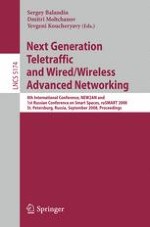2008 | Buch
Next Generation Teletraffic and Wired/Wireless Advanced Networking
8th International Conference, NEW2AN and 1st Russian Conference on Smart Spaces, ruSMART 2008 St. Petersburg, Russia, September 3-5, 2008. Proceedings
herausgegeben von: Sergey Balandin, Dmitri Moltchanov, Yevgeni Koucheryavy
Verlag: Springer Berlin Heidelberg
Buchreihe : Lecture Notes in Computer Science
